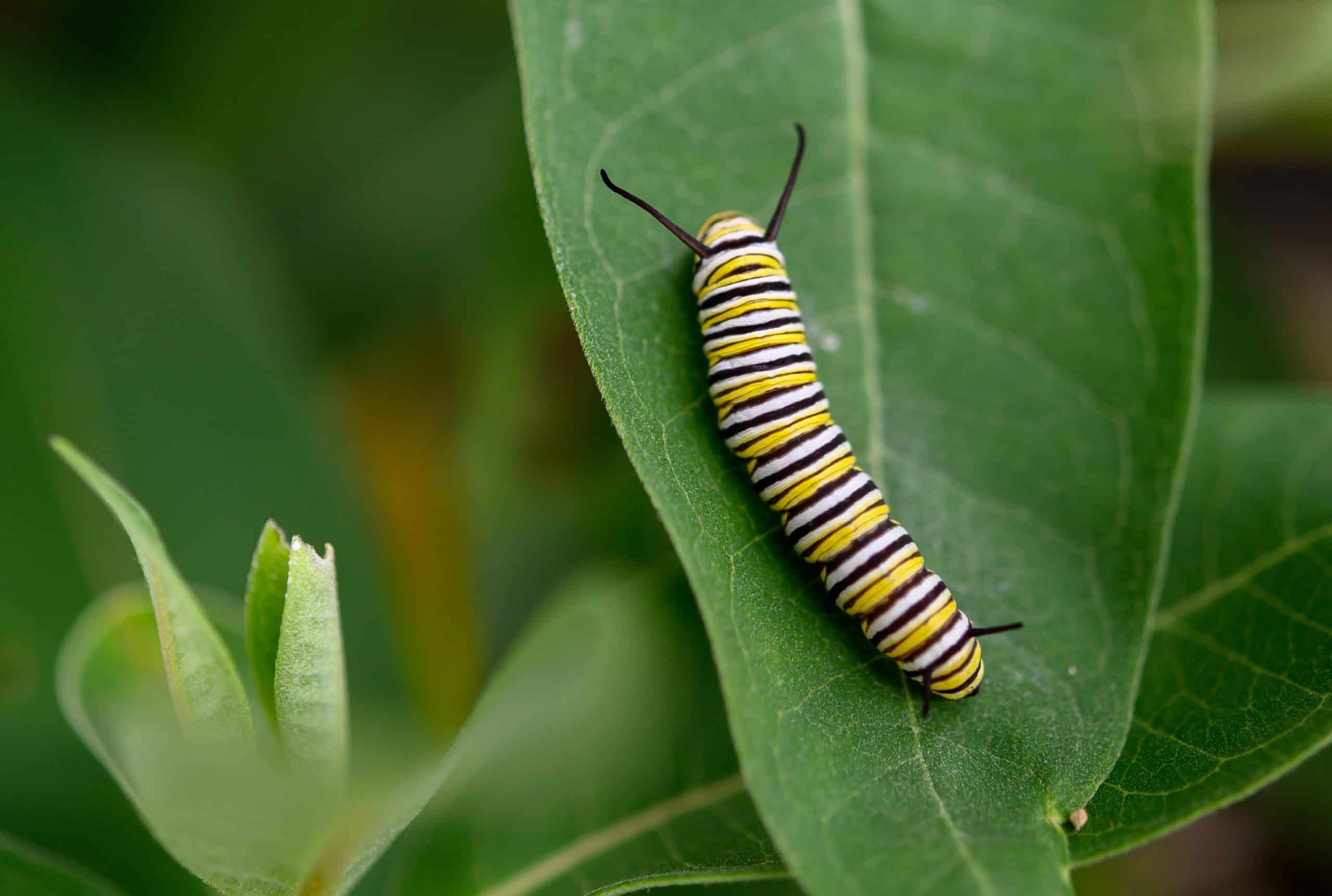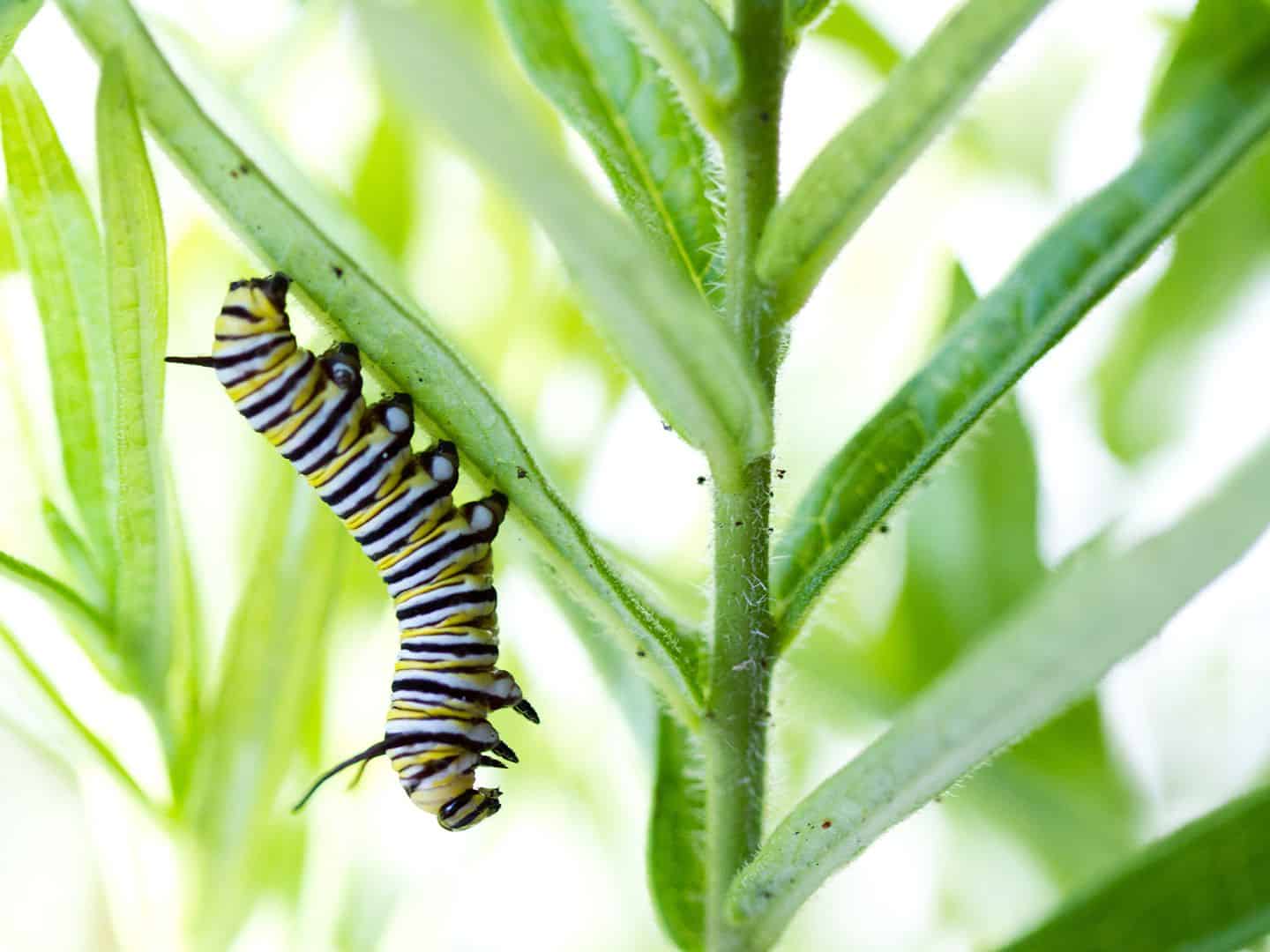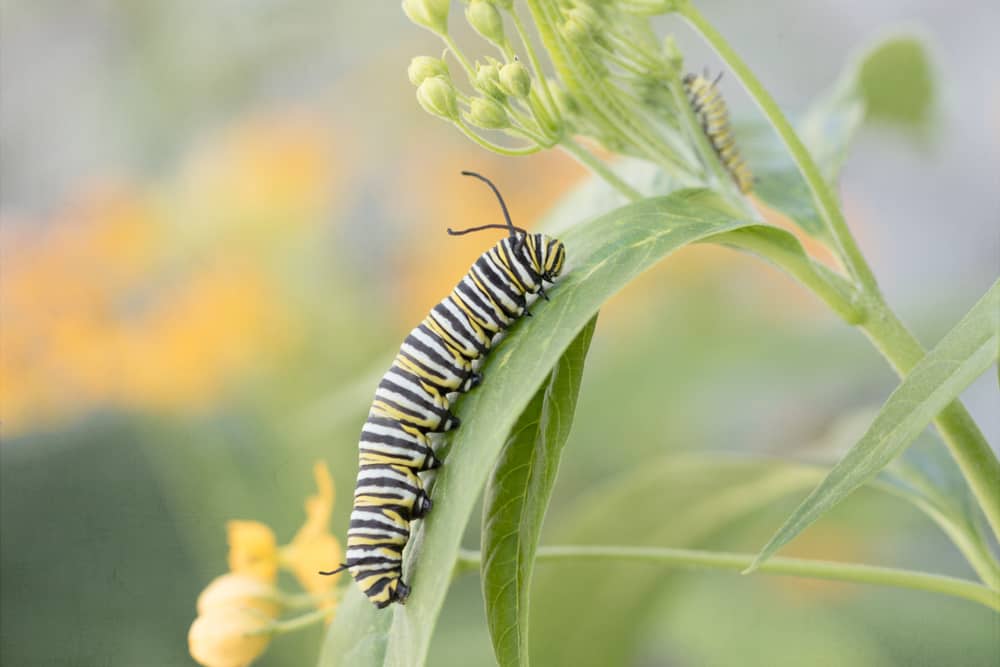As one of the most gorgeous insects, it’s always a delight to see monarch butterflies visiting our gardens.
With their amber wings and delicate features, monarch butterflies are an important pollinator and dash of color across North America. Not to mention the amazing migration that takes place every year.
But these beautiful creatures have humble beginnings like the ordinary monarch caterpillar. And if you’re interested in increasing monarch stocks, and want them to appear more frequently in your garden – we’re here to help.
Today we’re going to explore everything there is to know about monarchs – from what they eat, to where they live, and how you can properly identify them.
Facts about monarch caterpillars

Habitat
Habitats are the most important thing in nature – without them and animals and insects can’t live or thrive.
Luckily, monarch caterpillars are simple creatures that require just one type of plant to live on – native milkweeds!
Milkweed is a common plant found across America, and can be found growing along roadside ditches, paths, throughout farms and meadows, and in gardens too. Sadly, it’s considered a weed in gardens and removed on sight.
Thankfully, things are changing, with more gardeners recognizing milkweed as a vital ingredient to monarchs visiting their homes.
Milkweed (and their cousin butterfly weed) require very little (if any) maintenance to grow; all they need is bright sunlight, dry soil, and to be left alone!
Why do monarch caterpillars like milkweed?
Milkweed has a variety of chemical compounds including cardiac poisons that make them bitter-tasting and toxic to all vertebrates. The plant, however, doesn’t affect monarch caterpillars.
So when a caterpillar ingests milkweed, it builds up a level of toxins that predators soon learn making them dangerous to eat.
Monarch caterpillars have a distinct way they feed on milkweed leaves – and if you carefully examine the plant, you’ll spot the presence of monarch caterpillars almost immediately. That’s because these caterpillars feed on the center part of the leaf first.
If plants have an almost ‘hollow’ look, no doubt monarchs are busy feeding.
Resist the urge to spray plants with pesticides, as caterpillars make full use of the plant, from feeding off it, sheltering under it to eventually laying their eggs on the underside of leaves.
Monarch migration
Perhaps what makes monarch caterpillars and butterflies so impressive is their yearly migration. Across four generations, these butterflies will travel over 2,500 miles from the US, where they mate, down towards central Mexico where they hibernate. They use a combination of air currents to make the journey possible.
Monarchs travel during the day and roost at night, sometimes gathering in such large numbers they cover entire forests. These same trees are used year on year by generations of butterflies.
The migrating generation
Each generation during the migration lives for a different period. During the summer breeding season, for example, butterflies live for 2-5 weeks. They mate, lay their eggs, and die.
This next-generation travels further down to Mexico and overwinters. When they awaken in February, they become reproductively active and return north to where their parents came from. These butterflies can live for as long as nine months.
How do you build a monarch butterfly habitat?
Although milkweed is a necessary plant to have, there are other plants that you should consider for your garden to attract butterflies and nourish them.
Monarch butterflies are most active during the late summer and autumn months, so planting a variety of large flowers with flat surfaces that bloom at this time is vital.
These include goldenrod, New England Aster, tickleseed, and purple coneflowers to name but a few.
How to identify monarch caterpillars?

Thankfully there is lots of research and easy ways to identify monarch caterpillars from other species. Not only that but there are also ways of aging your caterpillars, ensuring you’re always one step ahead of the next change.
Features to look out for in particular include:
1. Eggs
Monarch butterflies lay eggs on a host plant to help their larva survive. And as we know, caterpillars only eat one plant – the common milkweed. Eggs are oval-shaped, somewhat translucent, and about the same size as the eye of a needle.
2. Caterpillar
Now let’s talk about the actual caterpillars themselves. As hungry monarch caterpillars grow, they molt. The periods between molts are known as ‘instars’. 5 instars can be used to properly classify monarch caterpillars:
1st instar: When the egg hatches, the caterpillars will eat their eggshell and move on to the plant they were laid on. They will be pale green with a black head. In time, the caterpillar will develop dark green stripes and dark triangular patches between its head and front tentacles. This stage lasts between 1-3 days.
2nd instar: The dark pattern becomes much clearer now and the caterpillar is no longer transparent. A yellow triangle appears on the head. This stage lasts between 1-3 days.
3rd instar: Triangle patches behind the head vanish. Yellow stripes become more visible. The first set of thoracic legs is small and close to the head. It’s during this stage that caterpillars feed in their signature cutting motion, hollowing out the center of the leaf. Caterpillars will curl into a ball if disturbed. This stage lasts between 1-3 days.
4th instar: The band-like pattern becomes distinct and visible. Male and females can’t be accurately distinguished. The body of the caterpillar can grow up to 25mm in length and 5mm in thickness. This stage lasts between 1-3 days.
5th instar: The fifth instar is the final one, and sees the most vivid colors yet on the caterpillar. Black bands look almost ‘velvety’. The body looks plump. The caterpillar chews small notches into leaves to make it fall into a vertical position. This stage lasts longer than others, between 3-5 days before they pupate.
3. Chrysalis / Pupa
Monarch caterpillars spin a silk material around themselves and hang upside down off the milkweed leaf. Inside, the butterfly begins to develop, including its wings and adult organs. The caterpillar will continue to develop between 8-15 days, depending on the weather conditions.
4. Monarch butterfly
Adult monarchs have unmistakenly beautiful; with their signature black, orange, and white markings. The wingspan of a fully grown monarch butterfly is four inches. Examine it closely and you’ll see black veins throughout, with beautifully ornate white dots on the outer edges.
Tips on raising monarch caterpillars
Want to get involved in raising monarch caterpillars? Interested in improving your local biodiversity and ecology?
Although providing milkweed and other nectar-rich flowers can be more than enough, sometimes you want to take a direct approach to improve monarch stocks in your locality.
Outdoors
Just like the milkweed plant they rely on, monarch caterpillars are relatively easy to help raise and nurture. That said, your work is not in vain – we need to do more to promote their numbers and keep their population growing.
The first thing you must do is grow and cultivate milkweed plants in and around your garden. Avoid spraying them with pesticides.
Leaf size varies between milkweed varieties, but generally, it’s taken for granted you can never have enough to feed monarch caterpillars – they have notorious appetites!
Regularly check milkweed for the presence of eggs, usually on the underside.
If you want to protect your caterpillars as they grow from eggs, you can follow what Kirsten Grace of the Florida Museum did, and create an outdoor, netted habitat for them.
Indoors
If you want to move eggs found indoors, carefully cut the leaf off the plant. Move it to a dedicated space for your caterpillars, in a room that receives lots of natural light.
Once hatched, caterpillars will need regular supplies of fresh milkweed to keep in tandem with their growth spurts. Have milkweed stalkers upright to allow caterpillars to move around.
Keep caterpillars hydrated by gently misting the enclosure. You can also place damp towels on the bottom.
In time, caterpillars will begin to pupate and hang downwards in a ‘J’ shape. In about two weeks, it will merge as a beautiful butterfly!
But don’t touch or interfere with them after they hatch. It will take a couple of hours for their wings to fully dry and harden.
Although people are tempted to keep these butterflies in their enclosure for a few days, you should release them as soon as possible. Don’t worry – they often hang around your garden for a lengthy time, so you can enjoy their beauty outside!
Wait until a clear, dry day before releasing them into your garden.
